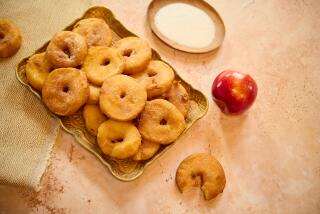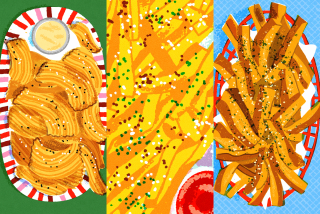Christmas Eve in Bruculinu : An Oily Christmas
- Share via
The traditional Sicilian Christmas Eve dinner is fried for a variety of reasons. First, ovens were owned municipally, or by the rich; and, in any case, roasting is inappropriate for the feast’s food, as prescribed by the Church.
More importantly, Sicilians take great pride and pleasure in showing abundance at the table, especially at holidays. At Christmas time, this abundance manifests itself in the use of olive oil, which has been one of the island’s main crops since the Greek conquest and colonization in the 8th Century B.C. As the holiday falls not long after the annual olive harvest, the extravagant use of the precious oil is possible.
The most important reason, however, is taste. There is no other cooking method that can turn something as commonplace as cauliflower into something splendid. By virtue of extreme heat, the process sears the outer surface of the food, locking in its flavor. As long as the oil is hot enough, and its structure has not been broken down by excessive re-use, the fried food will not be greasy.
Along the same lines, the use of extra-virgin olive oil is important. Though it has a lower smoking temperature than many other oils--and, therefore, must be treated with care--the flavor is not to be missed. Of course, for deep-frying, you need not use the precious Tuscan oils that come in perfume bottles. Find a moderately priced, good quality extra-virgin oil, such as Fior d’Oliva or Antica Italia, and buy a large can.
The flavor of properly fried food is festive in its tone, rich and subtle in its aspect and connected to the ages in its style.
* To fry artichokes: Set up a bowl of water with the juice and zest of one of lemon. Pass a knife through another lemon prior to each cut to prevent the artichoke from turning black. Cut off 1/2 inch from the top of the artichoke. Peel away the outer leaves to the place at which the leaves are pale green and thinner. Cut off the stem, cut the artichoke in half, and place in the bowl of lemon and water.
This seems like a monumental task, but after the first few, it moves along very quickly. Add the juice and zest of the second lemon to the bowl and let the artichokes soak 15 minutes.
Place a pot of water on the stove with the juice of two lemons and their zests. When the water boils, add the drained artichokes, cover, and cook for 10 minutes. Run under cold water to stop the cooking process.
Drain the artichokes thoroughly and pat dry. Pass the artichokes through flour, egg and bread crumbs. Then deep fry in the same way as the potato croquettes.
They can be fried in the same pot of olive oil, after the croquettes have been completed.
* To fry cardoons: Carduna , also called in Italian cardi or cardone , is a stalk-like vegetable with the texture of celery and the flavor of artichoke.
To cook cardoons, first peel off the strings and cut the stalks in 1-inch lengths. Blanch them in boiling water acidulated with lemon juice for five minutes. Drain and, when cooled, pat dry.
Pass the pieces through beaten egg and dust with flour. Pan-fry in extra-virgin olive oil until a rich, golden brown. Drain on brown paper. Serve with salt to taste.
* To fry cauliflower: Cut away and discard the stalk end and the green leaves. Cut the cauliflower in half and cut the florets away from the inner core. Soak the florets in cold salted water 15 minutes.
Meanwhile, place a steamer on the stove with several scrapes of nutmeg in the steaming water. When it comes to boil, drain the cauliflower and cook in the covered steamer 10 minutes. Run under cold water to stop the cooking process.
Drain the florets thoroughly. Pat dry. Coat with beaten egg and then flour.
Heat about an inch of extra-virgin olive oil in a skillet. Pan fry the cauliflower quickly at high heat until a light golden color. Drain on brown paper and serve.
* To fry fish: I have named several fishes in my article that are difficult to find in Southern California. If you are fortunate enough to find fresh sardines, be sure they are well gutted and scaled before cooking. Dust the fish in fine bread crumbs or flour, and fry in hot extra-virgin olive oil. Serve with salt and lemon. The taste is sublime. Whole small red mullet is an acceptable substitute, but be aware of the many tiny bones. Tiny smelts prepared whole in the same manner are quite excellent and plentiful here.
I do not recommend the use of blowfish fillets unless you are familiar with cleaning them. This fish has a poison sack that, if not properly removed, will cause grave illness, or worse, when the fish is eaten.
In addition to sole, our markets are filled with fish fillets excellent for frying: red snapper, orange roughy and thinly sliced shark, to name but a few. Merely dust the shark in flour, but coat all the others in the traditional flour, egg and bread crumbs. Fry the fish in about an inch of extra-virgin olive oil at high heat. Drain on brown paper. Serve with lemon and salt to taste.
POTATO CROQUETTES (Cazziddi) 2 pounds boiling potatoes 8 anchovies, chopped 4 eggs 1 cup grated Locatelli or imported Pecorino cheese Pepper Flour Bread crumbs Olive oil for deep frying, to equal about 2 quarts Sea salt
Peel and cut potatoes as for potato salad. In pot boil in lightly salted water until cooked but quite firm. Drain potatoes and begin to mash. Add anchovies while potatoes are still very hot so anchovies will melt. Continue mashing. Add 2 eggs, cheese and season to taste with pepper. When potato mixture is well cooled, begin to form croquettes.
Line work surface with wax paper. Beat remaining 2 eggs in shallow bowl. In another shallow bowl, place bread crumbs. With floured hands, form small handful of potato mixture into cylinder 1 1/2 inches thick and 3 inches long. Carefully roll croquette in flour. Place on wax paper. When all croquettes are formed and floured, roll 1 at time in egg, then bread crumbs, returning to wax paper.
Heat oil in 3 1/2-quart pot to 350 degrees, temperature at which small square of bread will brown quickly but not burn. Gently slip in croquettes, few at time. When croquettes are rich brown, remove from oil. Drain on brown paper. Croquettes can be kept warm in 300-degree oven, uncovered, until ready to be served. Season to taste with salt. Arrange in pyramid style on platter. Makes 16 croquettes.
Each croquette contains about: 117 calories; 235 mg sodium; 60 mg cholesterol; 4 grams fat; 13 grams carbohydrates; 6 grams protein; 0.25 gram fiber.


